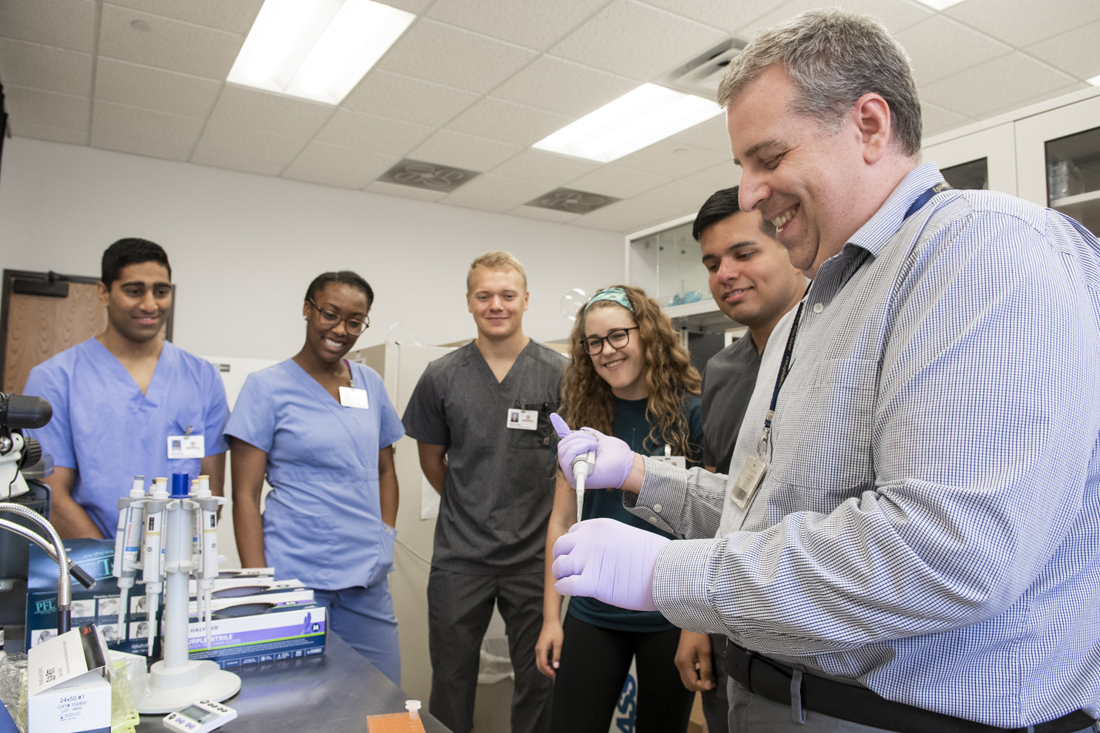Progress notes

Prioritizing and planning. That’s what keeps Dr. L. Bruno Ruest above the fray as he juggles his role as Predoctoral Student Research Program director with his own research and time in the classroom.
Ruest, associate professor in biomedical sciences, is motivated by his students’ “remarkable research” and relishes any opportunity they have to be recognized for their efforts. As the program gears up for another year — with nine more students committing to the research program than last year — it’s a wonder that Ruest initially hesitated in applying when the mentoring role opened up in 2015. That is, until students showed up in his office to persuade him.
“One day I had five to six graduate and former summer research students come to my office to convince me to apply because they saw I had what was needed for the position,” he says.
Since then, Ruest has planned and guided, mentored and led, cheering students on while simultaneously advancing student research on a national level. That includes judging at the annual Hinman Student Research Symposium, where Texas A&M College of Dentistry’s Research Scholars Day winners present their posters. Student benefits go well beyond that stage.
“Participation at national competitions is often a big boost when students are applying for specialty programs,” he says. “Judges at these competitions are from other dental schools and often are also on admission committees for specialty programs. The competitions provide name and school recognition.”
Guiding student research was a logical step for Ruest. Teaching has long been on his career radar, but a love for science took him down other paths first. Earlier this year, Ruest received the college’s Distinguished Teaching Award.
At what point in your career did you decide that you wanted to work with students?
When I was a kid, I liked school and I thought of becoming a teacher, then my interest in sciences led me somewhere else.
I worked with summer research students when I was a Ph.D. student and a postdoctoral fellow. I’ve been in labs that paired summer students with regular graduate and post-graduate trainees. I had the same type of partnership when I was a summer student in 1995. My first trainee at McGill University is now a physician at Stanford University and, interesting coincidence, my last trainee at the University of Louisville (before I became a faculty member here) became an OB-GYN.
After I came here, I continued working with summer research students. It’s not that I decided one day I wanted to work with students, but it is rather a continuity of what was started over 20 years ago, and I like it.
Has student research always been your mentoring focus?
Partly, since I’ve always had summer students working with me on a continual basis since 2002. After I arrived at Texas A&M College of Dentistry, my focus included graduate students and postdoctoral trainees. The last few years, I have focused mainly on the summer research program that, albeit the name, is almost a yearlong endeavor — American Association for Dental Research abstract submission in the fall, preparation for the AADR annual meeting and the college’s Research Scholars Day and recruitment in the spring.
What direction will the Student Research Group take now that there’s a change to year-round curriculum, shortening time available for students to conduct research?
The program will change. Currently the majority of students in the program are the new D2 students. They enlist toward the end of their D1 year. We have about 10 D0 (incoming D1) from year to year. We (along with Dr. Larry Bellinger’s office – Research and Graduate Studies) expect that we will take more D0 applicants and a few D2s who can have projects that are doable with a few afternoons each week. These kinds of projects are not common. I’m looking into taking college students who are participating in the summer program at Texas A&M University. Because of safety regulations, it’s difficult to take students from other colleges around town.
What methods do you use to recruit student participation?
For D1 applicants, I organize a meeting during the spring semester to explain the program and then send an application packet to the class. Interested students fill out and return the application. They are responsible for finding a mentor. For D0 applicants, I meet with them when they are here for their interview, explaining the research program. In February, early March, we send application packets to future dental students who have accepted the school’s offer into the program. Interested incoming D0 students send back the forms, which are then compiled and sent to the faculty for matching. Interested faculty send me how many D0 students they want. Based on the returns, I make the matchings.
What is your own research focus?
My work focuses mainly on craniofacial and cardiovascular development, particularly on neural crest cell patterning, although I may touch a few other things like periodontal diseases and pregnancy issues as long as they are related to endothelin signaling. I had a paper accepted in early June on cardiac neural crest cells.
What have the students taught you?
Different things — could be some new technology, patience, organization/planning, communication. Since the job is sometimes stressful, to have fun and, most importantly, to relax. In students’ words: “to chill.”